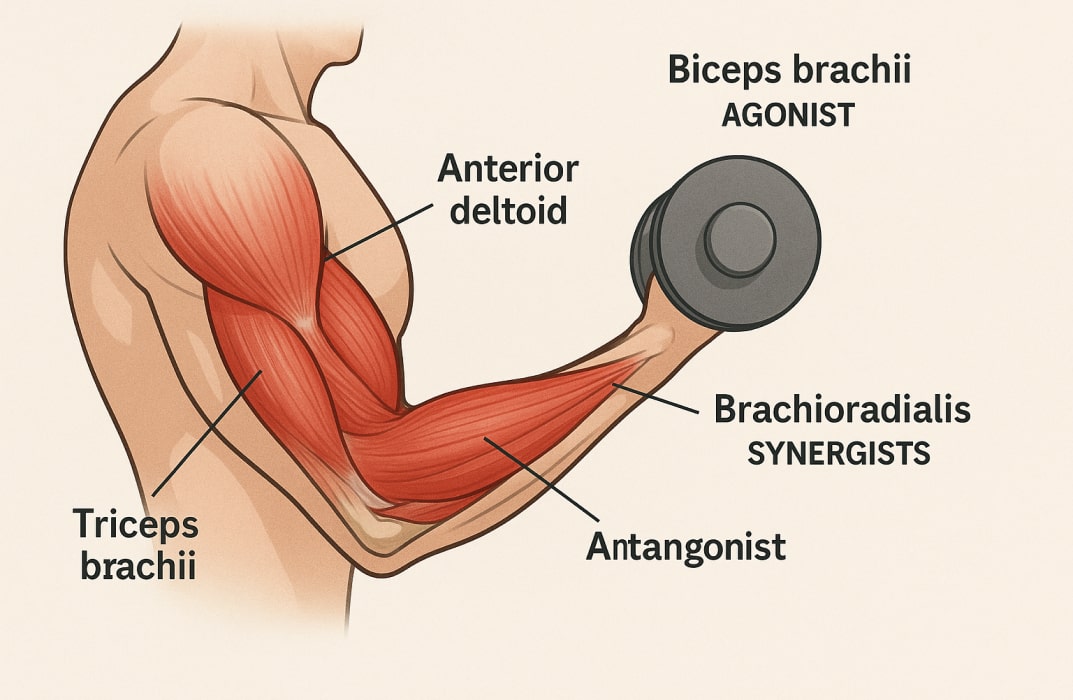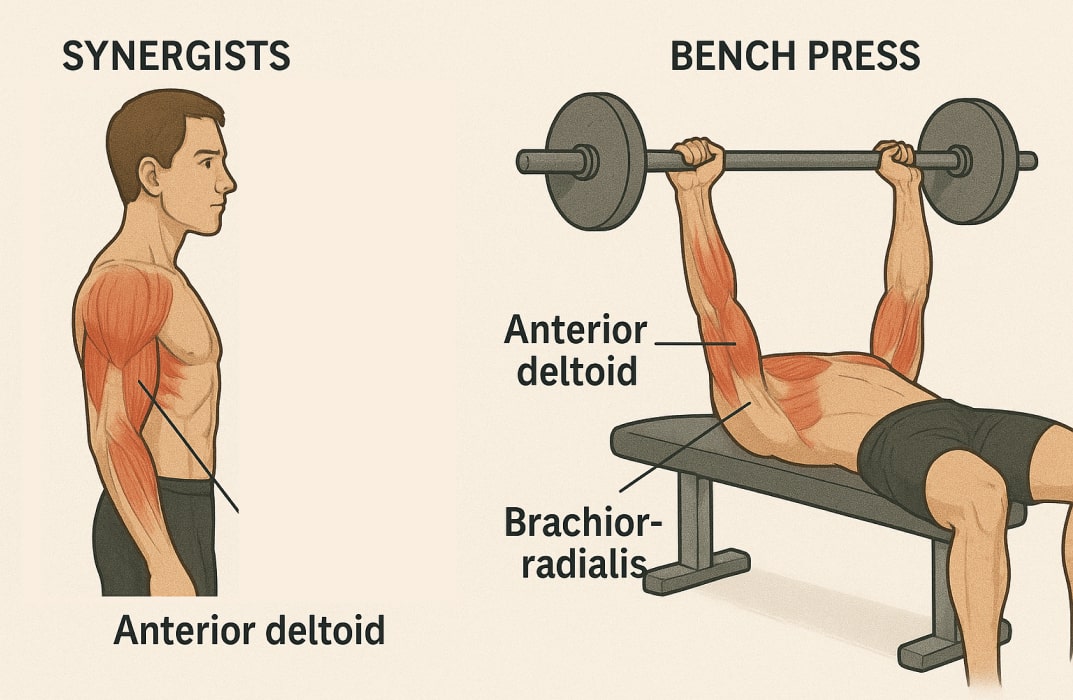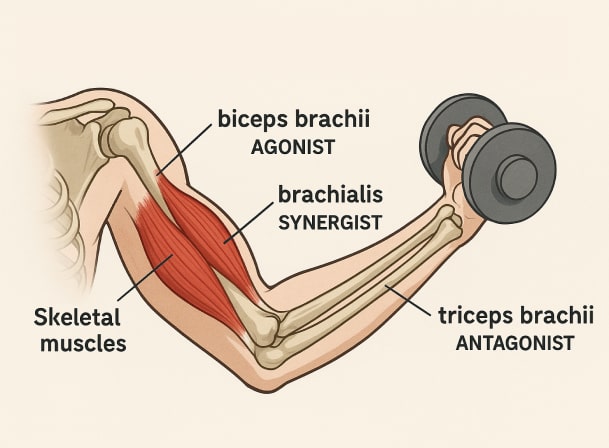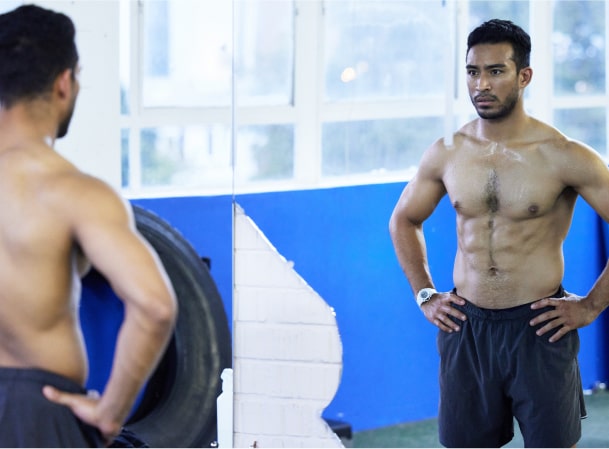Have you ever wondered how your muscles work together seamlessly when you lift, push, or pull? Every movement you make, from a simple bicep curl to a complex squat, involves a well-orchestrated teamwork of muscles. Among these, synergist muscles play a crucial, yet often overlooked, role in various movement patterns.
So, what is a synergist muscle? Simply put, a synergist is a muscle that assists another muscle in performing the same movement. These muscles are not the main movers—that role belongs to the agonist or prime mover. The agonist muscle is the primary mover responsible for producing specific actions by contracting to create movement, such as the biceps brachii during a bicep curl. In anatomy, understanding synergist muscles helps trainers, physiotherapists, and fitness enthusiasts improve performance, prevent injuries, and enhance coordination through the nervous system.
In this comprehensive guide, we will dive into what synergist muscle groups are, how they function, and provide detailed examples you can relate to everyday exercises.
What is a Synergist Muscle?
A synergist muscle is a supporting muscle that works alongside the agonist (or prime mover) to help perform a specific movement. While the agonist is primarily responsible for generating force for example, the biceps brachii during a bicep curl synergists assist by stabilizing joints, preventing unwanted movements, and adding extra strength when needed. Think of them as reliable teammates, ensuring each movement is smooth, efficient, and well-coordinated.
Understanding how synergist muscles function is essential for trainers, physiotherapists, and fitness enthusiasts. It enhances performance, improves neuromuscular coordination, and plays a key role in injury prevention..
Synergist vs Agonist vs Antagonist
Understanding how synergist muscles interact with other muscle roles is key to grasping movement mechanics. Here’s a simple comparison:
This table shows how the muscles work together, including the anal sphincters highlighting the critical role of the synergist in supporting smooth, controlled movement.
Key Functions of Synergist Muscles
Synergist muscles have several important roles:
- Assist the Prime Mover: They share the load, especially during heavier movements.
- Stabilize Joints: Prevent unwanted movements that could cause injury.
- Enhance Efficiency: Make movements more controlled and precise.
- Support Muscle Coordination: Work alongside other muscles to achieve smooth motion.
By understanding what a synergist muscle is, you can better design workouts, even those that involve standing erect prevent injuries, and improve overall movement efficiency.
How Synergist Muscles Work

Understanding how synergist muscles work is key to seeing why they are so important in every movement. While the agonist (prime mover) generates the main force, the synergist muscle supports the motion by assisting, stabilizing, and preventing unwanted movement. In short, the muscle attached to the join synergists make movements smooth, controlled, and efficient.
For instance, during elbow flexion in a bicep curl, the biceps brachii is the prime mover. However, the brachioradialis and anterior deltoid act as synergists, ensuring the elbow moves correctly without straining surrounding muscles.
Forearm flexion involves the coordinated action of the biceps brachii, brachioradialis, and brachialis to bend the elbow and move the lower arm. The brachialis, which is located deep beneath the biceps brachii, also plays a key role in flexing the lower arm during this movement. Without synergist support, the motion would be less stable and less effective.
Also Read: Effective Workout Tips for Accelerated Fat Loss
Roles of Synergist Muscles
Here are the primary functions of synergistic muscles:
- Assist the Prime Mover: They add extra force when the agonist needs help.
- Stabilize Joints: They prevent unwanted or excessive movements.
- Coordinate Movements: Ensure multiple muscles work together efficiently.
- Protect Muscles and Joints: Reduce risk of strain or injury during exercise.
Synergist Muscles in Action
Let’s look at some examples in everyday exercises:
While a single muscle can act as a synergist to assist the prime mover, most movements involve multiple synergists working together to support and stabilize the joint, providing additional force and enhancing movement efficiency.
This table demonstrates that the four muscles acting as synergists assist the prime mover across various exercises, highlighting their importance in strength training and functional movements.
Synergistic Contraction Explained
A synergetic muscle contraction happens when the synergist activates alongside the agonist. This coordinated effort allows:
- Heavier loads to be lifted safely
- Complex movements to be performed smoothly
- Reduced risk of injury by controlling joint movement
For example, during a bicep curl, the brachioradialis synergist contracts to stabilize the forearm, while the biceps brachii generates most of the lifting force. This demonstrates the muscle synergy that ensures efficient movement.
Practical Tip for Fitness Enthusiasts
When training, it’s important to engage synergist muscles properly. Focusing only on the prime mover may lead to imbalances, overuse injuries, or reduced efficiency. Exercises that involve multiple joints or compound movements naturally recruit synergists, helping you build strength, stability, and coordination simultaneously.
Types of Synergist Muscles

During a squat, the quadriceps femoris, located in the anterior compartment of the thigh, acts as the agonist for knee extension. In contrast, the hamstrings and gluteus maximus are part of the posterior compartment, contributing to hip extension and stabilization.
Synergist muscles are not all alike. Understanding the different types of synergist muscles can help you see how muscles coordinate to produce smooth, controlled movements. Broadly, the principal muscle synergist muscles are categorized into true synergists and stabilizing synergists. Both play vital roles in making movements efficient, safe, and powerful.
1. True Synergists
True synergists are muscles that directly assist the prime mover (agonist) in performing a specific movement. These muscles work alongside the agonist to increase force, optimize movement mechanics, and make actions more efficient.
For example:
- During a bicep curl, the brachioradialis helps the biceps brachii flex the elbow. Without this assistance, the movement could feel unstable or less controlled.
- In a bench press, the anterior deltoids assist the pectoralis major in pushing the weight upward, providing extra force and preventing undue strain on the chest muscles.
- In leg exercises like leg press, muscles such as the vastus medialis act as true synergists, supporting the quadriceps during knee extension.
Key point: True synergists primarily add force to the movement and share the workload with the prime mover, making them essential for lifting heavier loads or performing repetitive motions safely.
2. Stabilizing Synergists
Stabilizing synergists, on the other hand, don’t directly generate the movement. Instead, their main function is to stabilize joints, maintain posture, and prevent unwanted movement. They ensure that the prime mover can function effectively without causing joint strain or muscle imbalance.
For example:
- During a squat, the gluteus maximus and hamstrings stabilize the hips and knees while the quadriceps femoris perform the primary movement of knee extension.
- In a shoulder press, the upper trapezius stabilizes the shoulder blade while the deltoid muscle moves the arm.
- Even in simple movements like a tricep pushdown, stabilizing synergists in the forearm prevent the elbow from drifting or wobbling.
Comparison Table: Types of Synergist Muscles
Why Knowing the Types Matters
Recognizing whether a muscle is a true synergist or a stabilizing synergist is critical for anyone looking to improve movement efficiency and prevent injury. For fitness enthusiasts and trainers, this knowledge helps in:
- Designing balanced workout programs that target both prime movers and supporting muscles
- Preventing overuse injuries caused by neglecting stabilizers
- Improving functional strength and coordination in daily activities and sports
- Understanding muscle mechanics for optimal performance during complex exercises
Common Examples of Synergist Muscles

Understanding synergist muscles in theory is useful, but seeing real-world examples in exercises and movements makes the concept far easier to grasp. Synergist muscles assist prime movers in a variety of movements, providing stability, extra force, and precise control.
The muscle's insertion is the point where the muscle attaches to the bone it moves, allowing for effective motion. Synergists also help maintain proper body or limb position during movement, ensuring stability and coordination. By examining specific examples, we can understand how these muscles enhance performance and prevent injury.
1. Biceps Brachii as a Synergist
The biceps brachii is often recognized as the primary muscle called for elbow flexion, but it also plays a synergistic role in certain movements. For example, during a pull-up or chin-up, the four muscles include biceps brachii, brachialis, and brachioradialis assisting in flexing the elbow. This ensures the movement is smooth, controlled, and effective.
When performing a bicep curl, the brachioradialis acts as a true synergist, sharing the load and helping the biceps brachii lift heavier weights safely. At the same time, the tricep muscle acts as the antagonist, controlling and slowing the movement as the biceps brachii and synergists flex the elbow.
Additional points to consider:
- The biceps brachii helps stabilize the shoulder joint, preventing unwanted wobbling.
- It works alongside forearm flexors to enhance grip strength during pulling exercises.
2. Deltoid Muscle as a Synergist
The deltoid muscle is another important synergist, especially in upper body pressing movements. During exercises like the bench press, shoulder press, and chest flys, the deltoid assists the pectoralis major to generate force while stabilizing the shoulder.
Key points:
- Assists in shoulder abduction, flexion, and rotation, depending on the movement.
- Works in tandem with rotator cuff muscles to stabilize the shoulder joint.
- Provides additional force, allowing you to lift heavier weights or perform more repetitions efficiently.
3. Trapezius as a Synergist
The trapezius is often overlooked, but it plays a critical synergistic role during upper body movements. During exercises like upright rows, shoulder presses, and overhead lifts, the trapezius stabilizes the scapula and shoulder girdle, allowing the deltoids and rotator cuff muscles to move the arm effectively.
Key points:
- Helps maintain proper posture during lifting.
- Prevents shoulder impingement and joint instability.
- Works as a stabilizing synergist in complex shoulder movements, ensuring safe execution.
4. Gluteus Maximus as a Synergist
The gluteus maximus is a major muscle of the lower body that often acts as a synergist in compound movements like squats, lunges, and deadlifts. While the quadriceps femoris typically performs the primary knee extension, the gluteus maximus assists with hip extension and stabilization.
Additional insights:
- Helps prevent lower back strain by maintaining proper pelvic alignment.
- Works alongside hamstrings and adductors to support knee and hip joints.
- Critical in functional movements like climbing stairs or jumping, where joint stability is essential.
5. Pectoralis Major as a Synergist
The pectoralis major can act as a synergist when other muscles are prime movers in upper body exercises. For instance, during an overhead shoulder press, it assists the anterior deltoid and triceps brachii, contributing to smooth and controlled lifting.
Key points:
- Supports shoulder flexion, horizontal adduction, and rotation.
- Works with synergists to increase strength and efficiency in pushing movements.
- Stabilizes the shoulder joint, helping maintain proper form during exercises like push-ups, bench presses, and dumbbell presses.
Table: Common Synergist Muscles and Their Roles
Synergist vs Antagonist Muscles

When learning about synergist muscles, it’s important to understand how they differ from antagonist muscles. While synergists assist the prime mover (agonist), antagonists perform the opposite action, providing balance and control to contrast agonist performance.
Antagonists play a crucial role in controlling and slowing down muscle actions, especially during rapid movement. They help control rapid movement by regulating the speed and stopping the motion of a limb, ensuring that quick or rapid movements are stabilized and do not become abrupt or uncontrolled. Together, these muscle roles ensure smooth, coordinated movement.
Understanding the Roles
- Agonist (Prime Mover): The muscle primarily responsible for producing a movement.
- Synergist: Assists the agonist by adding extra force, stabilizing joints, and preventing unwanted motion.
- Antagonist: Opposes the movement of the agonist, controlling speed, and providing balance.
For example, during a bicep curl:
- Agonist: Biceps brachii
- Synergist: Brachioradialis and anterior deltoid
- Antagonist: Triceps brachii
The antagonist muscle doesn’t remain inactive, as it plays a role in voluntary regulation during the movement . Instead, it contracts slightly to control the motion and prevent injury, while the synergist ensures the movement is smooth and stable.
Why This Difference Matters
Understanding the distinction between synergist and antagonist muscles is critical for:
- Exercise Programming: Knowing which muscles assist and oppose movements helps design balanced workouts.
- Injury Prevention: Antagonists prevent uncontrolled motion, while synergists stabilize joints.
- Improving Performance: Coordinated activation of agonists, synergists, and antagonists ensures efficient movement.
Comparison Table: Synergist vs Antagonist Muscles
This table highlights how synergist muscles work with agonists, while antagonists provide counterbalance, creating smooth and controlled movement.
Agonist, Antagonist, and Synergist Working Together
All three muscle roles work together in harmony:
- During a push-up:
- Agonist: Pectoralis major
- Synergist: Anterior deltoid, triceps brachii
- Antagonist: Latissimus dorsi
- During a squat:
- Agonist: Quadriceps femoris
- Synergist: Gluteus maximus, hamstrings
- Antagonist: Hip flexors
By understanding these roles, trainers and athletes can maximize strength, stability, and coordination in every exercise.
Importance of Understanding Synergist Muscles

Knowing about synergist muscles is more than just anatomy knowledge—it’s a game-changer for anyone interested in fitness, rehabilitation, or movement efficiency, especially in maintaining proper limb position. Muscle synergists are essential for supporting coordinated movement and posture. These muscles help maintain body and limb position during movement and at rest. They play a critical role in how your body moves, how exercises are performed, and how injuries are prevented.
1. Enhancing Exercise Performance
When you understand which muscles are synergists, you can:
- Target movements effectively: Activating both prime movers and synergists ensures the exercise is performed efficiently.
- Lift heavier safely: Synergist muscles assist the agonist, allowing you to handle more resistance without risking injury.
- Improve coordination: Proper engagement of synergists helps your muscles work together seamlessly.
For example, during a bench press, knowing that the anterior deltoid and triceps brachii act as synergists allows you to maintain proper form and generate more pressing force.
2. Preventing Injuries
Neglecting synergist muscles can lead to muscle imbalances or overloading the agonist. This can cause joint instability and increase the risk of strains or tears.
- Squats: Engaging the gluteus maximus and hamstrings as synergists protects the knees and lower back.
- Pull-ups: Using the brachioradialis as a synergist reduces stress on the biceps and elbow joint.
Understanding these muscles helps train the body as a coordinated unit, reducing the risk of injuries during workouts and daily activities.
3. Rehabilitation and Physical Therapy
Synergist muscles are often a focus in rehabilitation programs because they assist in restoring movement without overloading the injured muscle.
- After an elbow injury, synergists like the brachioradialis can help maintain elbow function while the primary mover recovers.
- During shoulder rehab, stabilizing synergists like the trapezius protect the joint while the deltoid regains strength.
This makes understanding synergist muscles essential for physical therapists, trainers, and patients.
4. Functional Movement in Daily Life
Synergist muscles aren’t just important in the gym—they help in everyday movements:
- Picking up objects: synergists assist primary movers in lifting safely.
- Walking or running: hip and knee stabilizers prevent unwanted movement and maintain balance.
- Carrying groceries or children: synergist muscles stabilize the joints and support smooth motion.
By training synergist muscles along with prime movers, you improve overall functional strength, coordination, and joint health.
Table: Benefits of Understanding Synergist Muscles
Training Tips for Synergist Muscles

You might not think about synergist muscles as much as you do prime movers, but training them properly can improve strength, stability, and injury resistance. Incorporating exercises that specifically target synergist muscles helps enhance movement efficiency, improve muscular balance, and prevent injuries. Here are some effective strategies to make sure you’re engaging and strengthening your synergists during workouts.
1. Prioritize Compound Movements
Compound lifts like squats, deadlifts, bench presses, and pull-ups naturally activate multiple synergists.
- Squats: Recruit the gluteus maximus and hamstrings to assist the quadriceps femoris.
- Pull-ups: Engage the brachioradialis and forearm flexors as synergists with the biceps brachii.
- Bench Press: The anterior deltoid and triceps brachii act as powerful synergists to the pectoralis major.
2. Add Isolation Work for Supporting Muscles
While compound exercises do most of the work, isolation drills strengthen smaller synergists.
- Hammer curls target the brachioradialis, an important elbow flexion synergist.
- Hip thrusts and glute bridges strengthen the gluteus maximus, which supports squats and deadlifts.
- Lateral raises build the deltoid, which assists in pushing and lifting motions.
3. Train with Proper Form and Tempo
Rushed or sloppy reps reduce the effectiveness of synergist recruitment.
- Use a controlled tempo (2–3 seconds down, 1 second up) to allow stabilizers to activate.
- Keep joints aligned to avoid overloading prime movers.
- Example: In a bicep curl, avoid swinging your torso so the anterior deltoid and brachioradialis can properly assist.
4. Balance Agonist and Antagonist Work
Since synergists work with agonists and against antagonists, balance is essential.
- Train pushing and pulling equally (bench press vs rows).
- Include both quad-dominant (squats) and hip-dominant (deadlifts) movements.
- This prevents imbalances and strengthens the full range of muscle roles.
5. Use Progressive Overload Wisely
Increasing resistance gradually ensures that both agonists and synergists adapt together.
- Add small weight increments over time.
- Incorporate variations of core lifts (incline bench, Romanian deadlifts) to challenge synergists differently.
- Focus on mind-muscle connection—actively think about which assisting muscles are working.
Also Read: Full Body Circuit Workout and Its Benefits
Table: Training Tips for Synergist Muscles
Synergist Muscles in Sports and Athletics
In sports and athletics, performance depends on more than just strong prime movers. Synergist muscles play a critical role in providing stability, balance, and efficiency of movement. Skeletal muscle, the type of muscle tissue responsible for movement, is activated during athletic activities to facilitate these actions. Whether you’re sprinting down a track, swimming through water, or lifting a barbell overhead, synergists ensure that every action is coordinated and safe. For example, shadow boxing is a training method that engages synergist muscles to improve technique and muscle activation.
1. Running and Sprinting
When running, the quadriceps femoris is a primary mover, but synergists such as the gluteus maximus and hamstrings assist in hip extension and knee flexion.
- Benefit: Prevents knee injuries and helps generate explosive sprinting power.
- Example: The rectus femoris works with synergists during knee extension to keep strides smooth and powerful.
2. Swimming
Swimming requires coordinated muscle actions across the upper and lower body.
- During freestyle, the latissimus dorsi acts as the agonist while the trapezius and deltoids serve as synergists.
- They stabilize the shoulder joint, prevent injury, and enhance the pulling force.
- Benefit: Better endurance and reduced risk of shoulder impingement, a common swimming injury.
3. Weightlifting
In Olympic lifts like the clean and jerk or snatch, synergist muscles work overtime.
- The erector spinae and core stabilizers act as synergists, keeping the spine aligned during heavy lifts.
- The deltoid and trapezius assist the shoulders in overhead motions.
- Benefit: Increased lifting capacity with reduced risk of spinal or shoulder injuries.
4. Team Sports (Basketball, Soccer, Tennis)
Dynamic sports require fast changes in direction, jumps, and explosive movements.
- Basketball jumps: The gluteus maximus and hamstrings act as synergists with the quadriceps.
- Soccer kicks: The rectus femoris is supported by the adductors and hip stabilizers.
- Tennis serves: The pectoralis major is supported by the anterior deltoid and triceps brachii, ensuring a smooth, powerful swing.
Why Athletes Must Train Synergist Muscles
- Improved Stability: Prevents rolling ankles, collapsing knees, or unstable shoulders.
- Injury Prevention: Strong synergists reduce overuse injuries by sharing loads.
- Enhanced Power: Coordinated muscle synergy improves explosive strength.
- Better Endurance: Synergists help prime movers sustain longer periods of activity without fatigue.
Table: Role of Synergist Muscles in Sports
Why Synergist Muscles Deserve More Attention
When most people think about building strength or improving movement, they focus almost entirely on the prime movers—the “big” muscles like the biceps, quadriceps, or pectorals. But as we’ve explored, the synergist muscles are the quiet partners behind the scenes, making every action smoother, stronger, and safer.
So, what is a synergist muscle? It’s the muscle that assists another muscle, supports the agonist, and prevents unwanted movement. From stabilizing your shoulder during a tennis serve to powering your sprint on the track, synergist muscles are constantly at work.
The key takeaway? Don’t ignore your synergists. Strengthen them through compound movements, focus on proper form, and remember that fitness isn’t just about building big muscles—it’s about creating harmony across your entire muscular system.
92% trainers worldwide gave us 5 stars
Talk to your dedicated success manager and launch your branded fitness app during the demo in minutes.
Start your paid subscription for $79 FREE





%20to%20Become%20a%20Certified%20Personal%20Trainer-min.jpg)





